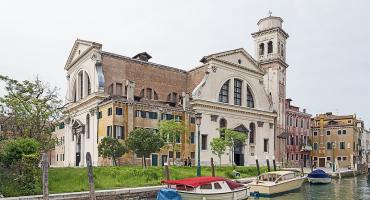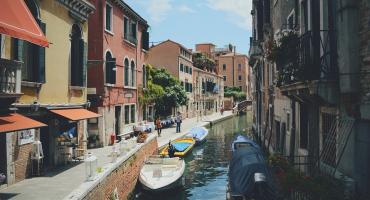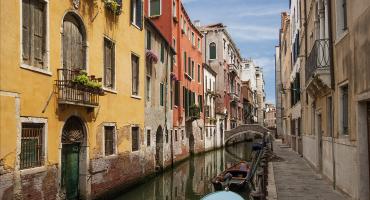The Rio delle Eremite, with its fondamenta, is a tranquil and secluded corner of the city, just steps away from the busy pedestrian artery connecting S. Margherita and S. Barnaba to the Accademia and the center. The rio runs alongside a convent complex built by Augustinian nuns who settled here in 1693, having previously lived in cells within the church of S. Marcuola.
The convents of the Augustinians were places where "citizen" girls were educated, while noble girls were destined for the convents of S. Zaccaria or S. Lorenzo. The hermit nuns of S. Marcuola (referred to as "romite" by the Venetians) who arrived in this area of the city, commissioned Giovan Battista Lambranzi, an architect and painter of that era (late 1600s), to build the church and convent, dedicating the two buildings to the Holy Family. They remained there until the Napoleonic era. Currently, Canossian nuns reside there, having adapted part of the convent into a school.
We explore this rio because it is an evocative urban environment; its charm does not stem from particular architectural beauties or flashy constructions: the church, in fact, is barely noticeable, aligned as it is along the fondamenta, with a facade featuring only a high semicircular window and two iron-barred windows flanking the door. Beyond the church is the long, austere wall of the convent, significantly altered in recent times, extending to the corner formed by the Rio delle Romite and Rio Malpaga, with rows of simple windows that draw our attention with their prominently protruding stone sills.
The urban elements in this landscape combine to form not a complex space, but a simple layout, full of air and light, with the fondamenta and rio running parallel to each other. As they curve southwards, they seem to elongate the path, further rhythmically marked by the small pillars and wrought-iron railings overlooking the water. The silence and seclusion here are palpable, offering a serene escape from the bustling city just a short distance away.
Bibliography:
- U. Franzoi - D. Di Stefano, Le Chiese di Venezia, Venice 1976.
- P. Molmenti, La storia di Venezia nella vita privata, 3 vols., Trieste 1981.
- G. Perocco - A. Salvadori, Civiltà di Venezia, 3 vols., Venice 1977.
- G. Piamonte, Venezia vista dall'acqua, Venice 1977.
- G. Tassini, Curiosità veneziane, Venice 1964.
- E.R. Trincato - U. Franzoi, Venise au fil du temps, Boulogne-Billancourt 1971.



